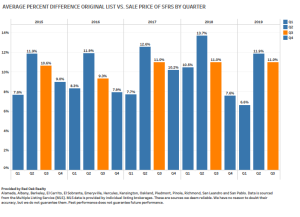
I occasionally answer questions in the real estate section of SFGate, participating in a column called Sound Off. When I started several years ago, one agent per week had an opportunity to respond to a question with enough space to give a fairly thorough answer. As demand to participate increased, they changed the format and now three agents are asked to respond to a question in 125-150 words. For someone like me, who likes to give thorough, and even nuanced answers, the size limitation is not very satisfying.
Two Sundays ago it was particularly frustrating to respond to what is really a multi-part question. (And I noticed the other contributors did not stick to the size limitations; I probably won’t either next time!) Here was the question:
“How do you go about setting a list price? Does pricing below market rate always cause a bidding war, or can that backfire?”
The article below is how I would respond, given more space. And even that is not all I’d like to share about pricing. Let me know if this topic interests you!
Right now the challenges of pricing are apparent in our autumn market, as each day, sometimes several times a day, I’m receiving messages from agents whose listings have not received the desired level of attention and price adjustments are required. I feel grateful, but also proud that is not a situation my sellers have experienced.
Pricing a listing is very much an art, not a science. It requires careful analysis of many factors of the property and the market. Local practice for the past several decades has been to price below market value, hoping that the low price combined with broad public exposure will inspire interest, resulting in multiple offers and a sales price both higher than list, and also higher than if the property were listed at market value. Overbidding varies both by City and by neighborhood within each City, with Berkeley leading the practice and commanding prices on average 10-15% over list price. But one needn’t venture very far afield to find communities where sales prices routinely stay close to list, or fall below. It’s primarily within the core of the East Bay and within San Francisco that pricing below market value is a key part of the marketing strategy of most listings, making pricing all the trickier to get right.
Of course receiving numerous offers, or creating a “bidding war†is not the goal, but actually having a strong offer close escrow. In my 23-year career, strategic pricing has indeed resulted in sales above list price for 100% of my listings, during all markets, strong as well as challenged! I could not achieve that remarkable record without staying well-informed of what’s going on in the immediate neighborhood of each listing, and observing first-hand how similar properties have been priced and presented, and how they were received.
Here are what I consider the key considerations for pricing a listing:
• Needs and goals of the seller
• Condition of the property
• Location, and its relative desirability
• Recent sales activity level in the neighborhood
• Recent nearby sales prices
• Time of year
• Approach and reputation of the agent: an important and under-appreciated factor
• General pricing approach in the area
• Overall economic environment
For a complete discussion of each of these key elements, read the article Tips for Strategic Pricing.